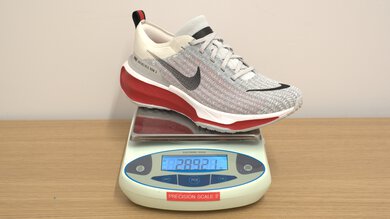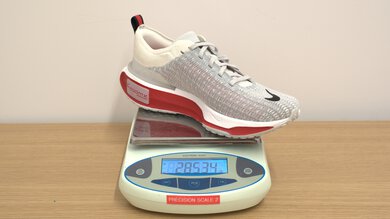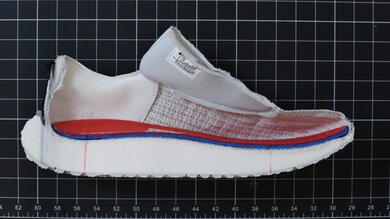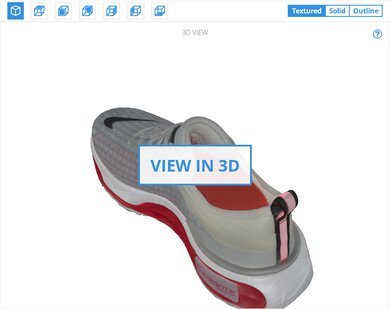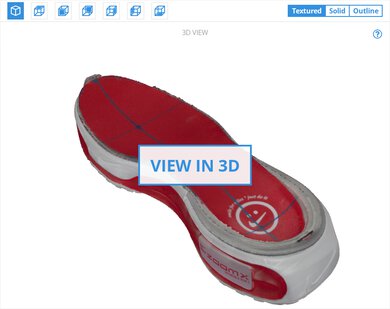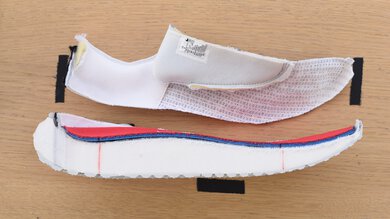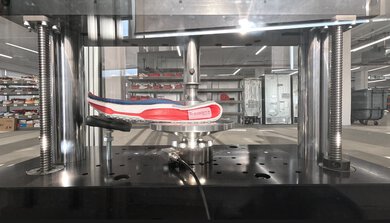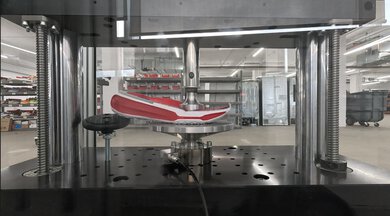The Nike Invincible 3 is a popular premium daily trainer. Designed to handle those easy-paced miles, it combines Nike's bouncy ZoomX foam with a supportive upper and a robust outsole, providing an enjoyable yet stable ride. Whether you're looking for an option for easy runs or a shoe that can handle some strides, this shoe delivers a blend of comfort and energy to keep you moving through most of your easy mileage.
Our Verdict
The Nike Invincible 3 is mediocre for marathon racing due to its heavier weight, which detracts from its good energy return and stability. It also lacks a carbon plate, which is common in high-performance marathon shoes.
-
Very energetic, especially for a trainer.
-
Heavy.
-
No plate.
The Nike Invincible 3 is okay for shorter races. It has a firm forefoot foam and good energy return, but its weight and lack of a plate limit its racing potential.
-
Very energetic, especially for a trainer.
-
Firm midsole at the forefoot.
-
Heavy.
-
No plate.
The Nike Invincible 3 delivers good energy return, thanks to its full PEBA-based ZoomX foam. The foam is quite responsive and springy, but the shoe is too cumbersome to handle it effortlessly. Still, the energetic midsole makes for an enjoyable ride for the bulk of your mileage.
-
Very energetic, especially for a trainer.
The Nike Invincible 3's cushioning is adequate, providing enough protection for most runners, though it may not be sufficient for those seeking exceptional cushioning. Applying significant force to the forefoot repeatedly can cause it to bottom out, reducing its overall cushioning and impact absorption potential.
-
Okay energy absorption.
-
Forefoot can bottom out over longer distances and / or higher forces.
The Nike Invincible 3 offers good lateral stability, which is beneficial for maintaining balance and form, especially on longer runs. That's mainly due to its very wide platform and firm forefoot foam.
-
Firm midsole at the forefoot.
-
Wide base.
-
No plate.
- 5.8 Marathon Racing
- 6.5 5K/10K Racing
Performance Usages
- 7.7 Energy Return
- 6.7 Cushioning
- 7.5 Lateral Stability
Changelog
- Updated Apr 02, 2025: Converted to Test Bench 0.8.
- Updated Apr 02, 2025: Review published.
Differences Between Sizes And Variants
We tested the Nike Invincible 3 in men's US size 9, as indicated on the label. The color we tested is White/Fire Red/Cement Grey/Black. This model is available in a wide range of colorways, from Black/Anthracite/Black to White/Platinum Tint/White/Photon Dust, with many options in between, including the Blueprint Edition, the Electric Edition, and the ability to design your own through Nike's custom-made platform. An extra-wide version is available, but only in men's sizes. The design section applies only to the exact model we tested, but we expect other size and gender variants to perform similarly.
Compared To Other Running Shoes
The Nike Invincible 3 is a good choice for runners looking for a daily trainer that offers a stable ride while still delivering the soft, bouncy feel of the premium PEBA-based ZoomX foam. It's well-cushioned for easy runs but has enough responsiveness to add some dynamism to your runs. If you're looking for a more protective premium trainer to cruise along on your recovery sessions, check out the Brooks Glycerin Max and the HOKA Skyward X.
While versatile, it sits in a middle ground within Nike's lineup, meaning more specialized options exist depending on your needs. For a more traditional daily trainer, the Nike Pegasus 41 offers a firmer, more grounded ride with less bounce. If you want something lighter and more tuned for speedwork, the Nike Zoom Fly 6 functions as a super trainer designed for faster efforts. For racing, Nike's top-tier options pair ZoomX foam with a carbon plate and are significantly lighter; check out the Nike Vaporfly 3 if you specialize in races up to 10K and the Nike Alphafly 3, which provides better efficiency for longer distances.
For more options, check out our recommendations for the best running shoes to find the perfect pair.
The Nike Invincible 3 and the Nike Vomero 17 are both daily trainers in Nike's lineup, but they have different strong suits. The Invincible features a full PEBA-based ZoomX midsole, giving it notably better energy return and making for a softer, bouncier ride. The Vomero, on the other hand, uses a mix of ZoomX and firmer EVA foam, making for a firmer and more controlled ride overall, at the expense of some energy return.
The Nike Pegasus 41 and the Nike Invincible 3 are both daily trainers, but they cater to different preferences. The Pegasus 41 offers a firmer, more grounded ride with better stability, making it a more traditional daily trainer. It's also marginally lighter. In contrast, the Invincible 3 is more cushioned, bouncier, and more versatile, thanks to its plush ZoomX foam, which makes it a better option for most.
The Nike Invincible 3 and the HOKA Clifton 9 are both popular daily trainers with a similar level of stiffness and stability, though the HOKA has a slight edge in stability. The HOKA is also lighter, making it feel a bit more effortless over longer distances. However, the Nike is a more premium daily trainer due to its bouncy ZoomX foam resulting in a plusher ride that feels more responsive underfoot. This added bounce makes the Nike more versatile, allowing it to handle some strides more easily. In contrast, the HOKA leans more toward consistent daily mileage with a balanced, reliable feel.
The Nike Invincible 3 and the Nike Vaporfly 3 serve very different purposes, with the Vaporfly 3 being a carbon-plated super shoe built for racing, while the Invincible 3 is a versatile daily trainer. As expected, the Vaporfly 3 delivers higher energy return, but the gap isn't as big as one might think, highlighting the impressive bounce of the Invincible 3 within its category. However, the Vaporfly 3 is nearly 100 grams lighter, making it far more agile and efficient, a day-and-night difference in terms of speed. Despite this, the Vaporfly 3 is also more cushioned, while the Invincible 3 provides better stability thanks to its wider base.
The Nike Invincible 3 and the Brooks Glycerin Max are both daily trainers, but they offer distinct experiences. The Brooks prioritizes max cushioning with softer foam and a higher stack height, providing better underfoot protection and a plush feel for long, easy miles. On the other hand, the Nike focuses more on energy return and stability, making it more versatile across a wider range of paces. However, this comes at the expense of some cushioning.
The Nike Invincible 3 and On Cloudmonster 2 are both popular daily trainers but offer distinct experiences. The Nike provides a noticeably bouncier ride, ideal for versatile daily runs. On the other hand, the On is slightly firmer and more stable, appealing to runners who prefer extra support and security underfoot, especially over longer miles.
Test Results
The Nike Invincible 3 is quite weighty. Notably, the upper feels bulkier than necessary. While marketed as Flyknit, the upper lacks the flexibility and breathability found in more premium and lighter Nike models like the Nike Vaporfly 3, which adds to the total weight.
This shoe delivers very impressive heel energy return, with ZoomX foam providing a high level of rebound for a daily trainer. The energy return is on par with or close to super shoes like the Nike Alphafly 3, making it stand out in its category.
This model offers good forefoot energy return. It delivers a springy toe-off, making it a solid choice for a smooth ride.
This shoe offers fair heel cushioning, making it suitable for easy days and recovery runs. The plush feel helps absorb impact effectively, providing a protective ride.
The forefoot cushioning on this shoe is just okay. At lower forces, it still absorbs impact well. However, heavier runners or those who apply significant force when landing on the forefoot may notice it flattening out, reducing its overall cushioning effect.
The Nike Invincible 3 is quite firm in the heel, but it's not that firm at higher forces compared to other shoes like the Nike Pegasus 41. This can be beneficial for heel strikers or when form deteriorates toward the end of a long run, providing a more forgiving ride. However, this comes at the cost of some stability.
The shoe's forefoot is incredibly firm across a range of forces. This rigidity enhances stability, ensuring a firm and controlled toe-off, but it may feel overly firm for runners who prefer more softness in the forefoot.
Comments
Nike Invincible 3: Main Discussion
Let us know why you want us to review the product here, or encourage others to vote for this product.
- 21010
What do you think RTINGS about this technology, and are you going to test it?
- 32120comment deleted
I feel like I have to make this post after I nearly cringed to death after seeing a number of wrong comments on the subject. So let me explain what it is and why you should use it. Virtual surround sound is the conversion of a surround sound source to binaural audio for headphones. Binaural audio has things called HRTFs, which improve the imaging on headphones. You can think of HRTFs as analogous to depth perception in vision, where each eye sees something a little different, and the composite has depth information. Similarly, spatial hearing has each ear hearing a slightly different version of something, and the differences are the spatial information. What the virtual surround DSP does, is it sees the 7.1 channels the game is outputting, and for each of the 7 directional channels, it adds in the differences between ears (the HRTF) that is appropriate for that channel’s location. Now if you had actual 7.1 speakers (not headphones), the physical location of the speakers would provide the appropriate HRTF. But since you are using headphones, you have to use the DSP. So with an appreciation of what virtual surround sound is, it is fairly straight forward to understand why you would want it. A 7.1 source is obviously going to be more spatially detailed than 2.0, and the virtual surround sound dsp is going to allow you to listen to it on headphones, through the use of HRTFs.
I know you know a lot about this subject, but a lot of reviewers actually don’t recommend using this 7.1 surround sound. Like I said a bad implementation can make it sound robotic or unnatural, and although it increases the soundstage, it really does nothing to imaging because in competitive games there’s really no benefit of using this technology other than open world games where the increased soundstage adds to the experience. So, no I’m not going to use it I’m more of an fps type of gamer, and yes I have experienced it, I found that it works really well in Just Cause 4, and not in games like fortnite. Either way, you can’t really call a 2 channel headphone a 7.1 surround sound headphone, because it only has 2 DRIVERS and it uses sofware to create the effect. I know there’s ‘TRUE’ 7.1 surround headphones but I’m not buying a headphones because of that technology, and in my opinion an open back headphones is way superior because of the open drivers, which produces a more natural, spacious soundstage.


